Horse grooming is the systematic care of the coat and feet of the horse. It is of particular importance when an animal is being worked. Proper grooming is just as important as appropriate feeding to the condition of the horse. Before you saddle up a horse, the horse must be groomed to remove any diet or matted hair from the area under the saddle. If this is not removed, it may cause rubbing and soreness. The horse’s hooves should also be picked out to remove any wedged-in stones, and feet and shoes inspected for maintenance before the horse is exercised.
After exercising, the horse should be cooled down and made comfortable before it returns to the paddock. On completion of moderate or strenuous exercise, particularly on a warm day, the sweat should be removed, and the horse cooled down with a hose. This keeps the coat clean and in good condition.
Why is Horse Grooming Essential?
A horse in work must be groomed systemically to keep the pores of the skin open and free from dirt and scurf. All horses should be groomed at least once daily. It is a misconception to imagine that animals on active service and in the open require no grooming. Unless proper grooming, the sweat glands cannot act efficiently, the horse’s skin will become unhealthy, and disease germs are likely to collect. Thorough grooming daily will keep a horse healthy, but to get the best appearance, a horse should be groomed twice a day.
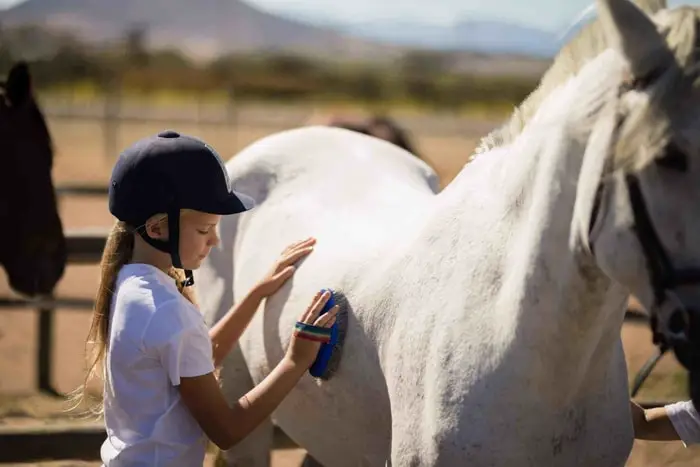 Reasons for Horse Grooming
Reasons for Horse Grooming
The significant reasons for grooming are:
- To ensure cleanliness and improve appearance.
- To maintain and promote good health.
- Decrease the scope of various health problems like thrush, scratches, and skin diseases by early identification.
- Establish a good companionship between the horse and its rider or caregiver.
- Grooming gives a chance for the health checking of horses like temperature, lameness, injury, and temperament.
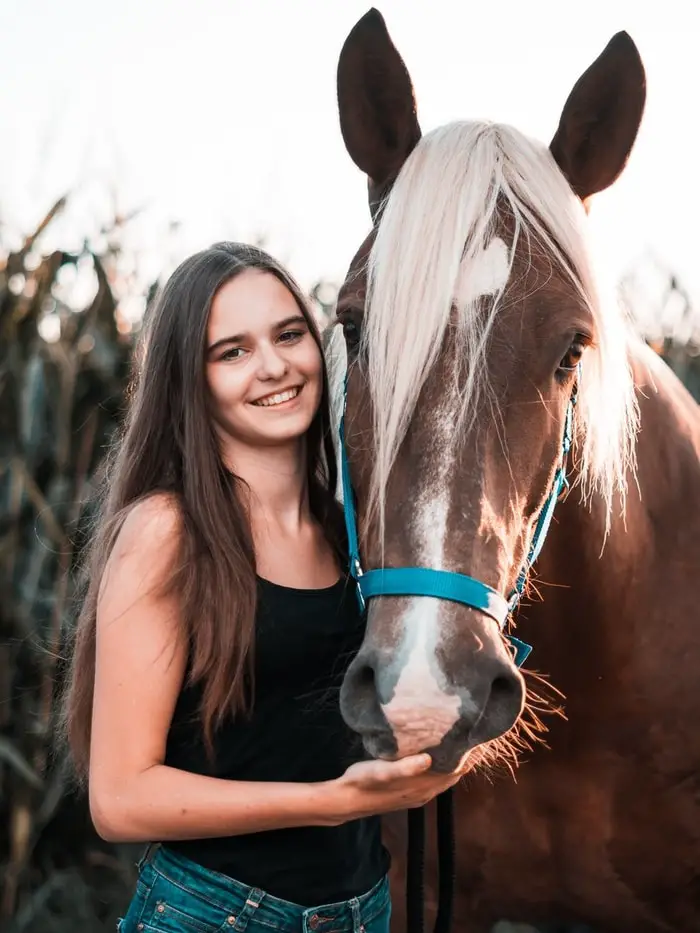
What are the grooming tools for horses?
Horse grooming is a sequential event and requires some specific tools or equipment. The grooming equipment includes:
1. A Dandy Brush. Dandy brushes are made of stiff whisk fiber. It is too firm to use as a body brush, and their use is limited to removal of hard-packed dirt, the rest of the grooming performed with a body brush.
2. Body Brush. Body brushes are made of stout bristles of plastic or vegetable fiber and have a broad hand-loop of webbing across the back to hinder the brush falling from the grasp. The use of the body brush is to detach dirt and scurf from the body, and for this purpose, the bristle brushes are better to those made of fiber. Fiber, however stiff at first, ultimately flattens down from the continued pressure on the brush and is then useless.
3. Hoof Picker. Hoof picker is a flat iron hook made in “S” shape with one end rounded to hold and another end to clean the central and lateral sulci of frog and sole of horse’s hoof.
4. Cloth Sponge. The sponge is commonly used during grooming for the lips, eyes, dock, and nostrils. Though the benefit of sponges for this purpose is obvious, they should invariably be stopped on the occurrence of any contagious disease, as they are one of the commonest channels by which infection can be spread.
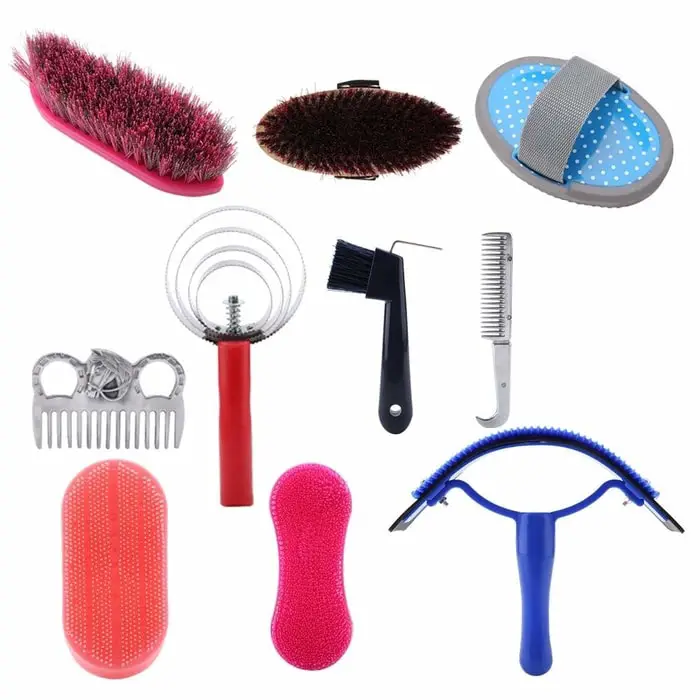
5. Curry Comb. The service pattern of the curry comb is consists of several straight, blunt toothed blades in metal back, with wide loop webbing for the purpose of bonding it on the back of the hand. It is essential that the teeth should be blunt and smooth, and in the work pattern, they are rounded at the bottom and top. This prevents the bristles from being unduly worn away when the comb used to clean the body brush and also guards against wounds to the skin when used for removal of dirt.
6. A Water Brush for cleaning the feet, mane, and tail.
7. A Mane or Tail Comb. The short mane is swept by a wide-toothed plastic comb. Long mane and tail are cleaned or groomed by a dandy brush or a human comb.
8. A wisp, for massaging and finishing the horse.
9. A rubber or Grooming Towel for proper shining the horse and removing of sweat after riding.
10. Sweat Scraper. It is a simple curved and flatted metal, around 18 inches long. It is used for removing excess sweat after riding or exercise and water after bathing for the natural dry of the horse’s body.
11. Shedding Blade. A metal, curved, blunt-ended shedding blade used in the winter to shedding the extra hairs and cacked-on mud. You must be very careful using the metal equipment as they may cause injury to the skin, reduce the shininess of coat, and irritation.
12. Scissors. Curved or straight metallic scissors are used to trim extra-long mane, hairs on fetlock, and banging the tail, or cutting the bridle path.
Preparation before Grooming of Horses
Horse grooming is one of the best welfare to your horse. You must take some preparation before starting the grooming of your lovely horse. The preparatory measures for the grooming are:
- You must select a clam and quiet place for grooming the horse’s box, preferably.
- You must keep the grooming equipment in a safe place so that the horse cannot accidentally kick.
- You must take all the necessary grooming kit in a box.
- Maintain a regular schedule for grooming every day.
- Maintain a sequence of grooming all the time.
- Before exercise, you must groom go for light grooming for about 10 minutes.
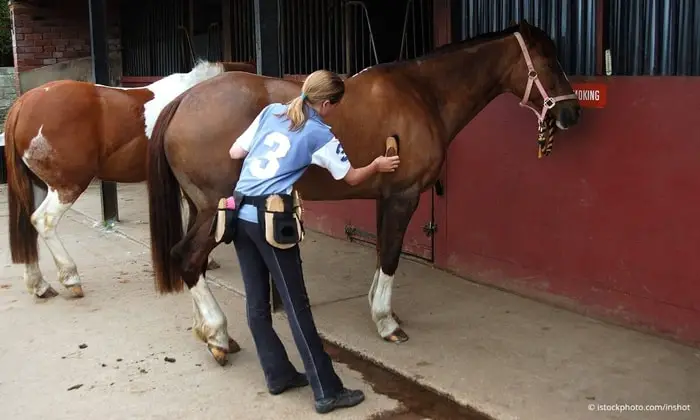
The Sequence of Horse Grooming
The grooming is a subsequent event that aims the clean the horse, health inspection of the horse, and enhance the circulation in the skin and body extremities.
1. Clean Hooves. This should be done at the outset of every stable hour and when a horse comes back to stables after being out for any purpose. The objective is to remove any stone that may have trapped between the frog and the shoe and to remove wet dirt, which might cause thrush. Special care must be paid to the cleft of the frog, the sides of the frog, and round the inside of the shoe.
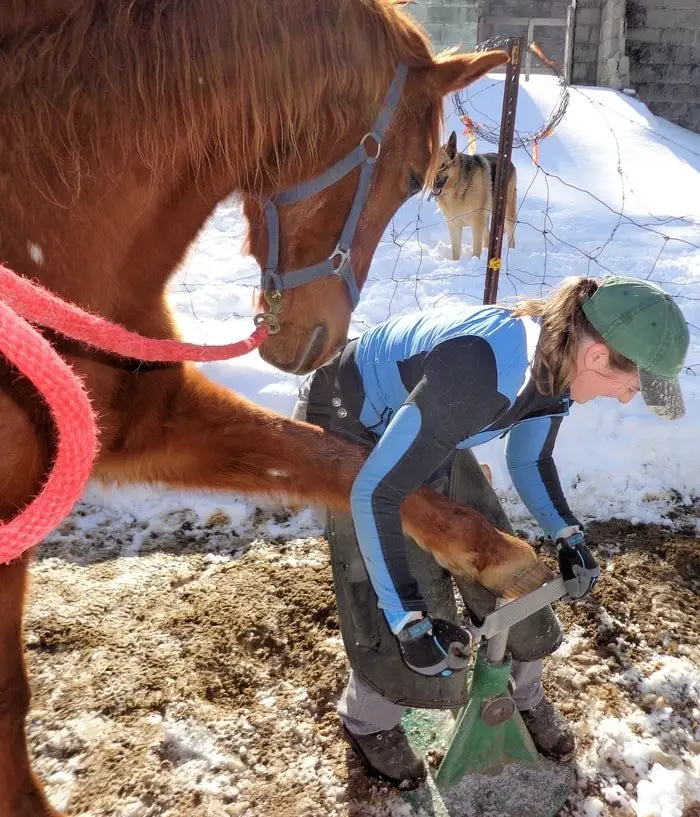
The pick of the clutch knife is supplied for this purpose, but any substantial iron spike or hook will serve. The point should be filed off dull. It must not be employed with any more vigor than is absolutely necessary, and the end must not be imposed down the sides or cleft of the frog.
2. Dry the Horse. A wet or sweating horse should be walked about outside for 15 minutes to allow him to dry and should not be brought into the box unless this is absolutely unavoidable. To dry him, rub opposite to the lay of the coat with a handful of loose straw or hay, which must be continuously renewed. The most important portions are the belly, flanks, and heels.
3. Sponge. When the horse is dried, he should be curbed, sponge his eyes, lips, nostrils, and dock. The sponge must be continually ringed in clean water, and especially after being finished with for the day.
4. Hand Rubbing. This is an excellent form of palpation and is especially useful for removing long or loose hair and for drying the horse’s back after removing the saddle. The hands are slapped down smartly on the body one after the other, and the weight of the body is leaned upon them. The forearms should be used as well as the hands for massaging the horse with a resistant pressure, which should be done both against the direction of the lay of the coat. The legs should be hand-rubbed every day in an upward trend. This facilitates the activities of the veins and lymphatics and prevents the horse’s leg from becoming “gummy.”
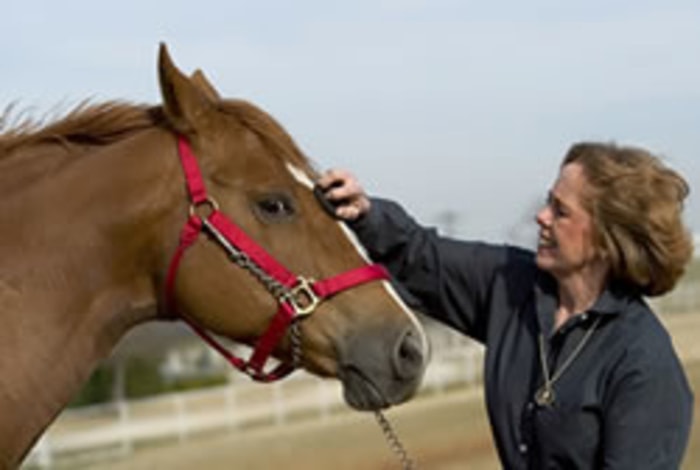
5. Horse Grooming- Brush. The horse should be brushed after sponged. A horse may be damp with sweat beneath the saddle and, at the same time, mainly dry on the other parts of the body. In this case, a starting may be made with the limbs, leaving the saddle on with girths undone or wrapping the back with a folded blanket. If the back is dry, the legs will usually be cleaned last.
To clean the body, start at one side of the neck immediately behind the ear and brush out the coat with the body brush, using the brush with a circular stoke for the most part in the direction of the lay of the hair. The brush may be used against the hair if there is much scurf or hard dirt.
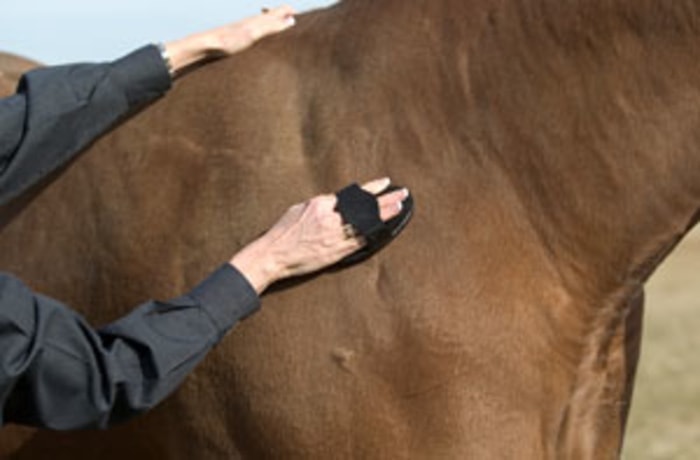
Brush all parts of the body, working towards the tail. When you brush sensitive areas, such as inside the legs and the groin, stand close to the horse and to the side so that it cannot kick you. Finish one side, then do the other. Use the left hand on the left side of the horse and right hand on the right side. Put your weight behind the strokes.
6. Use of Curry Comb. The curry comb is used for cleaning the brush and should not be applied to any part of the horse. It should be carried on the back of the hand so as to enable the man to lean his hand against his horse if necessary. The dirt must be knocked out of the curry comb by tapping the latter on the ground behind the horse in a place from which the soil can be swept away.
7. Use of Wisp. The primary use of the wisp is the massage of the horse’s body, thereby raising muscle, refreshing a tired horse, and improving the coat. Wisp only the neck, shoulders, quarters, and thighs to tone the muscles. Bang the-wisp or pad down with reasonable force and make a short stroke in the direction of the coat.
8. Rubber. Polish the horse’s coat with the rubber, which should be slightly damped and used like a wisp.
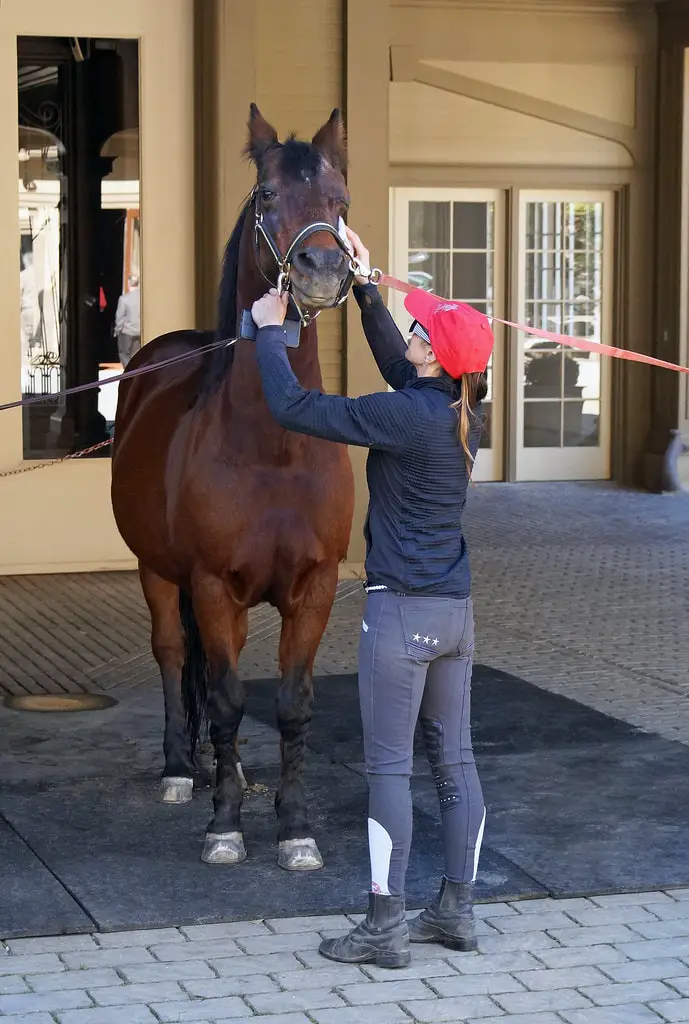
9. Cleaning Ears, Eyes, Nose, and Dock. The horse eyes, ears, nose, and dock should be cleaned after grooming with a damp sponge. The sponge should not be wet enough to release water in the eyes or ears. Sponge around the lips, then nostrils. You can put the sponge right into the nostrils to clean inside. You must use a different sponge to clean the dock area. Gentle sponge under the dock and the whole area under the tail.
How long does it take to groom a horse?
Grooming is the best horse welfare, which keeps him healthy and working fit. The sequence and activities I have mentioned earlier require a considerable time. You must spend at least one hour to groom your horse correctly. The timing of each event is given below:
- Visual Inspection for 5 minutes.
- Cleaning of Hooves-5 minutes
- Drying the horse- 5 minutes
- Sponge -5 minutes
- Hand Rubbing- 10 minutes
- Brushing- 15 minutes
- Cleaning of eyes, ears, nose, and the dock for 5 minutes.
- Laying of Tail and mane- 5 minutes
- Final Inspection for 5 minutes.
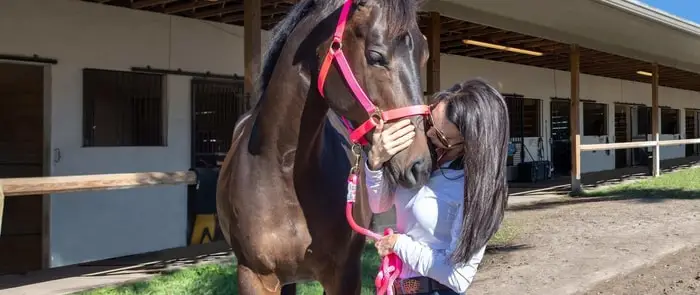
Horse Grooming: Bathing
Horses should be bathed in summer. In cold weather, however, the climate may not permit this. A perspiring horse can be cooled down and cleaned better this way. While washing, particularly a hot and tired horse, water must be poured on the back, the underbelly area, hands should be run over the legs, to remove sweat and dirt. After washing, the excess water should be scraped with a scraper. The mane and tail can be cleaned with soap or shampoo to washout the excess dirt or grime.
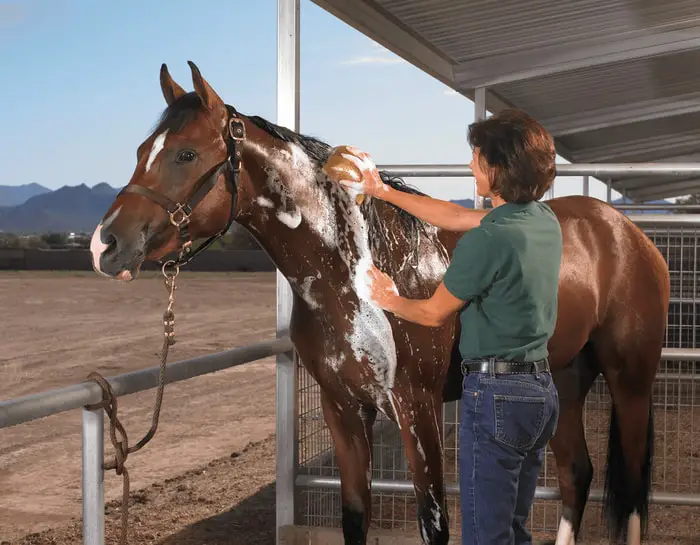
Horse Grooming: Clipping
Clipping is the term called to describe the shaving away of the horse’s coat with a clipping machine, a clipper. Clipping may be required for a variety of reasons. These are:
- To prevent excessively sweating.
- To prevent colds due to heavy coats that hold sweat and dry slowly in cold weather.
- For easy cleaning.
- For a smart look.
- For veterinary and health reasons.
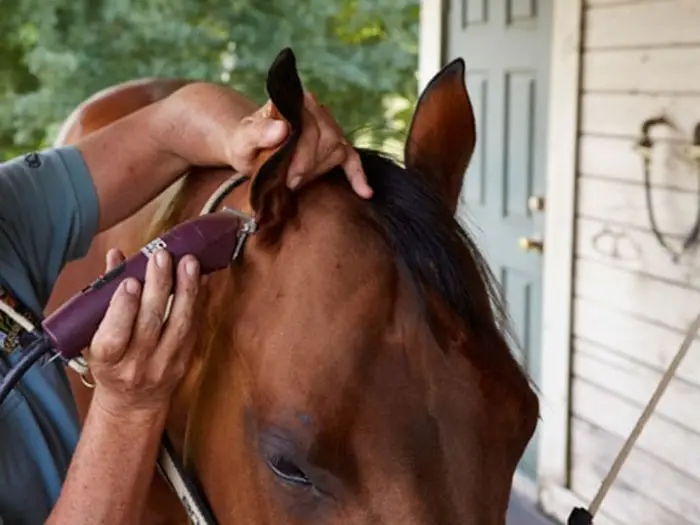
Horses are usually clipped in the winter after excessive hair growth occurs. There are various types of clips suited to the different kinds of work the horses are doing and the stabling facilities. Proper care of the clipped horse is critical. Ideally, the clipped horse should be stabled or rugged to prevent it from getting cold or losing condition. The types of clipping are:
- Hunter clip.
- The blanket clip.
- The medium trace clip.
Horse Grooming: Laying The Mane
Laying the mane encourages the hairs to lie flat and look neat. Wet the water brush and shake it once to remove excess water. Place it on the base of the mane and brush from the roots downwards.
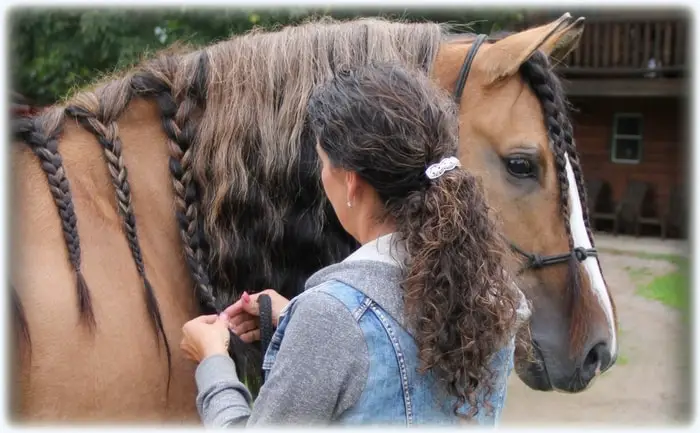
Grooming of Horse: Laying The Tail
Lay top of the tail with a water brush in the same way as the mane. Pay particular attention to the short hairs, which would otherwise stick upwards. When you finish the tail, you can bandage it to keep it tidy.
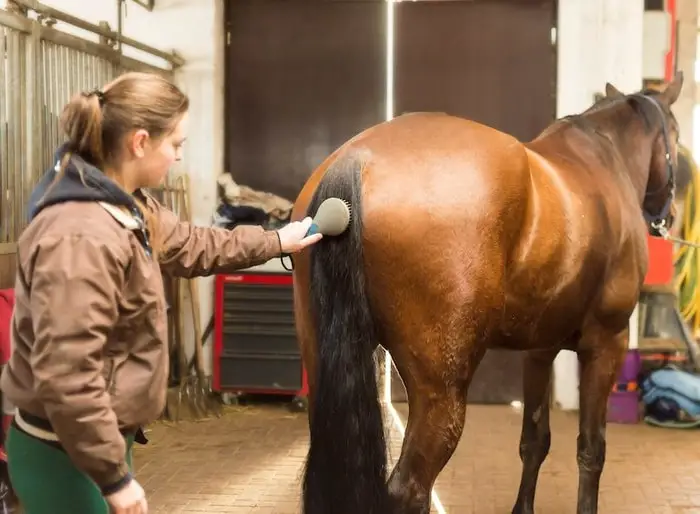
Horse Grooming: Rugging
It is often advisable to keep your horse rugged, particularly during winter. A cold horse loses weight rapidly, so keeping your horse warm and dry should be a high priority. Horses in moderate to massive work programs are often clipped or have thin, beautiful coats. Under these situations, it is necessary for the horse to be covered with at least two body rugs and a neck rug to keep it warm. The lighter woolen, doner, or synthetic rugs are suitable as under-rugs. Two layers of rugs are also required for stabled horses, although the heavy canvas rug can be removed when the horse in the box.
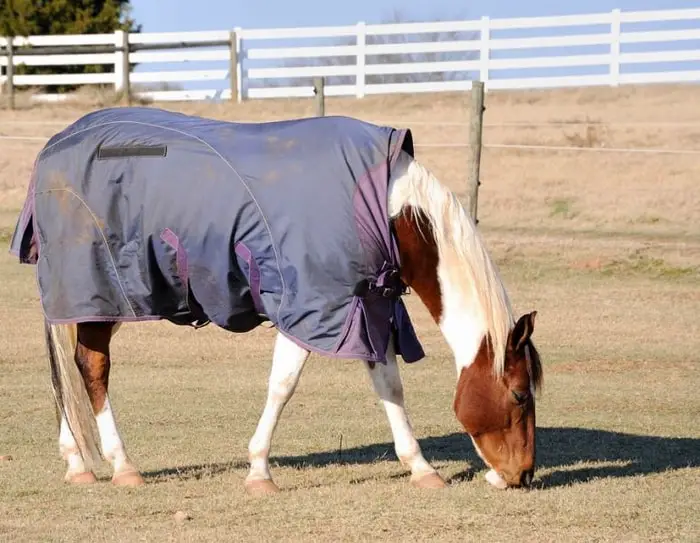
Excellent Feed for Good Skin
A balanced horse diet is necessary to keep your horse healthy and as well as for healthy skin. Deficiency of specific vitamins and minerals will cause skin diseases, hoof diseases, lameness, and laminitis. There are numerous supplements that are available in the market for healthy skin and hoof growth. You should select a supplement containing Omega-3 fatty acids, biotin, vitamin E, vitamin B complex, and mineral oils.
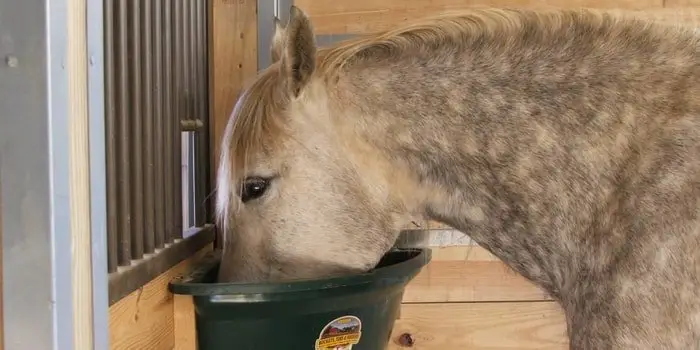
Helpful Tips on Grooming For Your Lovely Horse
As a horse rider or owner, you must take care of your horse correctly. Grooming helps to keep your horse healthy and working fit. The helpful for the grooming are as follows:
- Groom your horse every day.
- Groom your horse twice a day, if possible.
- Select a specific time of grooming and maintain that schedule.
- Groom your horse for at least 60 minutes.
- Maintain a sequence of grooming.
- Particular attention should be given to hooves, eyes, ears, nostrils, and dock.
- Provide excellent and balanced feed to your horse.
- Improvement of skin and hoof use some supplements.
- Bathe your horse at a regular interval with soap or shampoo.
- Clip the extra hair carefully.
- In case of any abnormality, report to the vet immediately.
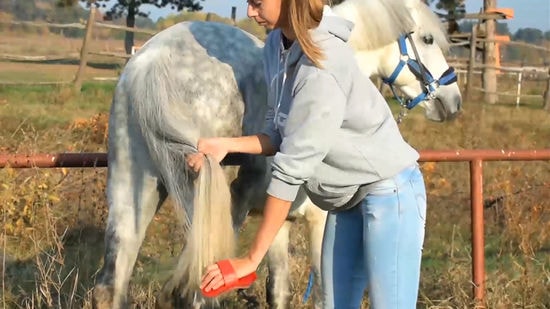
Take Away on Horse Grooming
Grooming is the regular activities of the horse stable that must be done every day. A systemin and sequential grooming keep your horse healthy, riding fit, and excellent looks. Grooming also builds good relations with the owner and the horse. You can understand horse behavior by regular grooming. I have discussed almost ass aspects of horse grooming in this article for your easy understanding. If the above information assists you, please share it with your friends via social media.